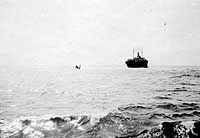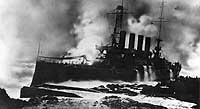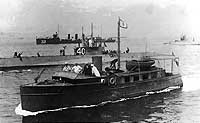Return to Naval Historical
Center home page.  Return to Online
Library listing
Return to Online
Library listing

DEPARTMENT OF THE NAVY -- NAVAL HISTORICAL CENTER
805 KIDDER BREESE SE -- WASHINGTON NAVY YARD
WASHINGTON DC 20374-5060

Archive of Older "What's New in the Online Library of
Selected Images?" --
Entries posted in January through March 2005
This page features the Online Library's 'What's New?' entries
for January through March 2005.
For the more recent entries, and links to previous years'
entries, see:
What's New in the Online Library
of Selected Images.

This report's
most significant offering is a new album: The Bureau
of Ships' "Spring Styles" book for the period from
late 1939 through 1944. It presents more than seventy drawings
prepared by the Bureau's Preliminary Design Section during studies
of a variety of proposed ship designs, some of which were built
and some of which were not. These plans are presented in a format
large enough to facilitate close study, and provide valuable insights
into the concepts and compromises involved in producing new types
of Navy ships. We hope our patrons (some of whom have been commendably
patient in waiting for this project to reach completion) will
find them both interesting and useful.

Two events
have been recently posted. Both represent accidents, one with
tragic consequences and the other a most remarkable survival story.
The first is the boiler
explosion on the gunboat Bennington, which took the
lives of five dozen members of her crew. July 2005 will mark the
100th anniversary of this awful incident, a monument
to which, erected atop the Point Loma hills, can be seen from
ships passing in and out of San Diego Harbor, California. The
second event, the accidental
loss of the submarine S-5 at the beginning of September
1920, had a much happier outcome. After a day and a half trapped
inside their nearly completely sunken sub, under miserable conditions,
all of S-5's crew were saved. Text remains to be written
on this event, but the pictures are there now.
As part of these two projects we also prepared complete picturial
coverage on the two ships involved: USS Bennington
(Gunboat # 4) and USS S-5
(Submarine # 110), as well as on their Commanding Officers,
both of whom later reached flag rank: Rear Admiral Lucien
Young and Admiral Charles
M. Cooke, Jr..

In addition
to those two ships, we posted pages on another four submarines,
one old torpedo boat and eleven destroyers. The subs are: L-2 (Submarine # 41),
O-2 (Submarine # 63),
R-14 (Submarine # 91),
and Sargo (SS-188).
Torpedo boat is MacKenzie
(Torpedo Boat # 17), and the destroyers are: Terry
(Destroyer # 25), Sigourney
(Destroyer # 81), Anthony
(Destroyer # 172), MacKenzie
(Destroyer # 175), William
Jones (DD-308), Terry
(DD-513), Anthony
(DD-515), Young
(DD-580), MacKenzie
(DD-614), Sigourney
(DD-643) and Stormes
(DD-780). Name sources for some of these ships are also among
the recent additions, including: Lieutenant Commander Alexander
Slidell MacKenzie (1842-1867) and Sergeant Major William
Anthony, USMC, (1843-1899). Other newly posted ships from the period from 1920 through
World War II, and later, are stores issue ship Cybele
(AKS-10), tugs Kalmia
(AT-23) and Kalmia
(ATA-184), and tank landing ship LST-757.

We have
a vast quantity of World War I era acquired vessels, beginning
with the hospital ship Comfort
(AH-3), and three cargo ships that also served as troop transports
in 1919: Santa Clara
(ID # 4523), Santa
Paula (ID # 1590) and Santa
Rosa (ID # 2169). There are also eight cargo ships that
retained that role for their entire Naval service: Choctaw
(ID # 1648), Clare
(ID # 2774), Cohasset
(ID # 3679), Corozal
(no ID #), Craster
Hall (ID # 1486), Kamesit
(ID # 3829), Santa
Barbara (ID # 4522), and Santa
Rosalia (ID # 1503), Other auxiliary ships include the
oiler Chinampa
(ID # 1952), salvage ship Chesapeake
(ID # 3395), and tug Conestoga
(SP-1128, later AT-54). The latter disappeared with her entire
complement in 1921, and we also added a page on her Commanding
Officer, Lieutenant Ernest
L. Jones.

Moving
into the ranks of WWI acquired patrol vessels, there are nine
yachts, three of which had prior service beginning in 1898: Emerald (SP-177), Felicia (SP-642),
Florence (SP-173),
Freelance (1898-1899,
and SP-830), Gem
(SP-41), Guinevere
(SP-512), Henry P. Williams
(SP-509) -- which was USS Oneida in 1898-1915, Juniata (SP-602),
and Kemah (SP-415).
Larger patrol craft (all ex-fishing vessels) include Comber
(SP-344), Commodore
Maury (SP-656), Comet
(SP-772) and Congress
(ID # 3698). Their smaller running mates are: Chichota
(SP-65), Chingachgook
(SP-35), Clarinda
(SP-185), Cleo
(SP-232), Coco
(SP-110), Commodore
(SP-1425), Constance
II (SP-633), Corinthia
(SP-938), Cossack
(SP-695), Coyote
(SP-84), and Cozy
(SP-938).

Taking
a deep breath, we move on to harbor service craft and the like
that were taken into service during the "Great War"
era. Harbor tugs lead the list, including Concord
(SP-773) -- which was later renamed Mendota and Muscotah
(YT-33), Cherokee
(SP-458) -- lost at sea in February 1918 with most of her
crew, Credenda
(ID # 3278). Other self-propelled vessels are the dredge Clapet Number 4 (no
ID #), steam lighter Commerce
(ID # 2763, later YF-123), work boats Clifton
(SP-2080) and Cometa
(no ID #), and the harbor utility vessels Clio
(ID # 2279) and Commander
(SP-1247). In the non-self-propelled category we find: Christine (ID # 2058),
Christiana (ID
# 2396) -- which became Coal Barge # 426, Concrete
Barge # 1 (ID # 2531) -- which became Coal Barge #
516, and Curacao
(ID # 2269) -- which became Fuel Oil Barge # 36. Lastly
(for this paragraph, at least), there are three ocean-going steamers
and a tug that were examined for possible service, but not taken
over by the Navy. The wooden freighter Alanthus
leads the way, by right of heroism. Her small crew's performance
was critical to saving the crew of the sunken submarine S-5.
Other big ships are Chipchung
and City of Savannah.
The tug is Columbia.

March's
contribution to earlier pictorial history is USS Fulton
(1837-1861), the second steam-powered ship built for the U.S.
Navy. In honor of the impending arrival of baseball season, we
offer a just-discovered (in our collections, anyway) photo of
the great Cleveland "Indians" pitcher Robert
A. ("Bob") Feller, who hurled 40mm projectiles (with
a little help from then-modern technology) at about 27 times the
speed of his usually blazing fast-ball, while serving as a gunner
on the battleship Alabama
during World War II
Finally, lest anybody think all the above represents a normal
month's output, rest assured that many of the items listed were
holdovers from an excessively ambitious January and February agenda.
31 March 2005

Our initial
2005 "What's New" report comes to you only about a month
overdue, as the rocks and shoals (mainly the latter) of subject
page compilation kept hanging up the great ship of progress all
through January and February. Anyway, what follows represents
rather more than a good month's work, expanded (as sagely defined
by that great Naval historian, C. Northcote Parkinson) "to
fill the time available for its completion."
Our most significant new subject is the armored cruiser Tennessee of 1906, whose
loss in August 1916
(soon after she had been renamed Memphis) provides a timely
reminder that powerful tsunamis afflict the Caribbean, as well
as other parts of the World.

Related
subjects include the gunboat Castine,
which barely escaped the tsunami that wrecked the Memphis;
Captain Edward L. Beach,
Memphis's Commanding Officer at the time of her loss (and
father of a well-known author of Navy historical and fictional
books); Rear Admiral Claud
A. Jones, the wrecked ship's Chief Engineer; and Annie
Keith Frazier (later Mrs. R.N. Somerville), Tennessee's
Sponsor, who in 1908 was a founder of the Society of Sponsors
of the United States Navy.

As is
usually the case, we added several destroyers and related types,
including Gwin (Torpedo
Boat # 16), Monaghan
(Destroyer # 32), Gwin
(Destroyer # 71), Osborne
(Destroyer # 295), Lewis
Hancock (DD-675), Rich
(DD/DDE-820) and Rinehart
(DE-196). Also recently posted are pictorial presentations
on the officers for which most of those ships were named: Lieutenant
Commander William Gwin,
Ensign John R. Monaghan,
Dental Corps Lieutenant (Junior Grade) Weedon
E. Osborne, and Lieutenant Commander Lewis
Hancock, Jr.
New undersea craft are L-1
(Submarine # 40), O-1
(Submarine # 62), S-3
(Submarine # 107) and Sealion
(SS-195). The latter was the first U.S. Navy submarine lost
during World War II.
Also recently joining the Online Library are three other Second
World War era vessels: Teton
(AGC-14), Samar
(ARG-11) and PT-96.

The ongoing
project to keep bright an earlier generation's effort to "keep
the World safe for democracy" is represented by the usual
flood of World War I era acquired (or potentially acquired) ships
and craft. Among the larger of these are three troop transports:
Santa Elena (ID # 4052),
Santa Elisa (ID # 4352)
and Santa Luisa
(ID # 2873); cargo ships Celebes
(ID # 2680), Challenger
(ID # 3630), Charlton
Hall (ID # 1359) and West
Elcajon (ID # 3907); and yachts Druid
(SP-321) and Emeline
(SP-175). Patrol boats include Celeritas
(SP-665), Cero
(SP-1189), Chanticleer
(SP-663), Charlie B.
Mason (SP-1225), Charmian
II (SP-696), Helori
(SP-181) and Scoter
(SP-20). Acquired tugs are Challenge
(SP-1015, later AT-59 and YT/YTM-126), Charles
P. Crawford (SP-366), Charles
P. Kuper (SP-1235) and Chase
S. Osborn (SP-1121, later YT-41).
Lastly, there are some vessels considered, but not (or apparently
not) taken into service: harbor tugs Atlantic,
Brilliant,
Charles T. Gallagher
and Radiant;
steam lighter George
H. Johnson and barge Charles
S..
28 February 2005
This page features the Online Library's 'What's New?' entries
for January through March 2005.
For the more recent entries, and links to previous years'
entries, see:
What's New in the Online Library
of Selected Images.
 Return to Online Library listing.
Return to Online Library listing.
Page made 31 March 2005
